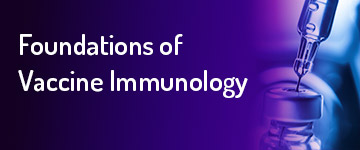UMORE - Pharmacy
Foundations of Vaccines Immunology
Foundations of vaccine immunology

More information? call us 1300 305 228 or email MedicinesAustralia.CEP@utas.edu.au
Foundations of Vaccine Immunology builds a practical understanding of human immunology as applied to vaccination, which will equip you with a holistic knowledge of how vaccines work, how vaccines are developed, and how they are used to fight disease.
A grounding in human anatomy and physiology is recommended, although not required, as a prerequisite for this elective program.
Foundations of Vaccine Immunology is comprised of 7 modules and is estimated to take approximately 18 hours to complete. A certificate will be provided upon completion.
The cost of this short-course is $490 for students who are employed by companies who are members of Medicines Australia, and $700 for non-members.
| Module | Topics covered |
|---|---|
| Module 1: Introduction | This Module introduces the context of vaccination: what it is, a brief history of vaccines, and how they work. |
| Module 2: Viruses and Bacteria | To understand vaccines we must understand the diseases they are designed to treat. This Module examines how viruses and bacteria cause disease. |
| Module 3: Immunology | Vaccines prevent disease by training our immune system to recognise and respond to threats. This Module explores the processes of our immune system and how it responds to infection. We investigate vaccine components and cases in which vaccine failure may occur. |
| Module 4: Vaccine Technologies | This Module examines and compares the different technologies vaccines can be built upon, from traditional methods such as Live Attenuated Virus, through new methods such as mRNA and DNA, to proposed methods such as Bacterial Vector. |
| Module 5: The Vaccine Journey | The journey of a vaccine from discovery through to delivery of safe, effective, high-quality vaccines. This module investigates this journey and the national immunisation programs and policies that run concurrently to ensure sustained access, safety, and protection against vaccine-preventable diseases. |
| Module 6: Vaccine Profiles | As with any medicine, there are important considerations for how vaccine products are made, delivered, and used. This Module explores product characteristics of vaccines and challenges you to apply the knowledge learned from all previous modules through the comparison of a series of COVID-19 vaccine products. |
| Module 7: Immunising a Population | This Module explores the many challenges in effectively administering a vaccine to a population, and eventually achieving control or eradication of a disease. We investigate epidemiological factors and how vaccine coverage relates to adverse events, hesitancy and disease spread. |
Intended Learning Outcomes
At the end of the program, students should be able to:
- Describe viral and bacterial pathogenicity and the body’s immune response to infection
- Explain how vaccines take advantage of immune system mechanisms to establish immunological memory
- Describe different types of vaccines (live attenuated, inactivated or dead, toxoid, subunit, DNA/RNA-based, outer membrane vesicles, viral vectors, bacterial vectors, virus-like particles); comparing vaccine products based on key characteristics and platform technologies
- Understand key considerations of vaccine research and development, regulation, policy and practice that enable sustainable access
- Explain vaccine regulation in Australia and ongoing safety surveillance
- Explain immunity thresholds and the relationship between vaccine coverage, adverse events, vaccine hesitancy and disease spread
